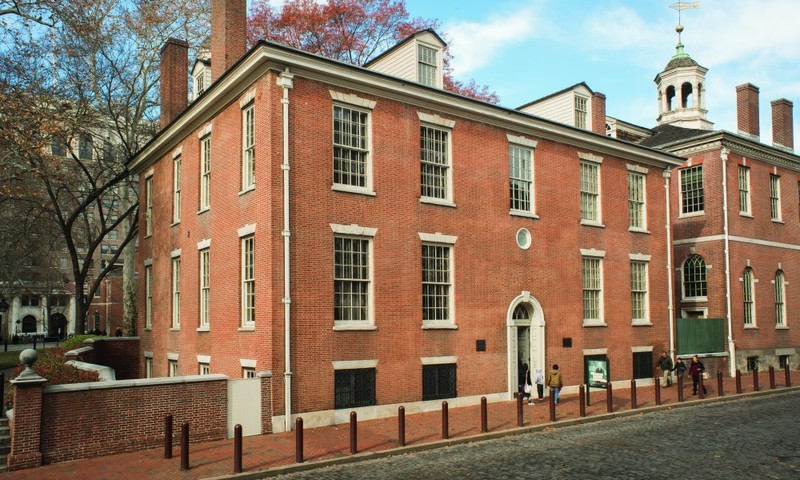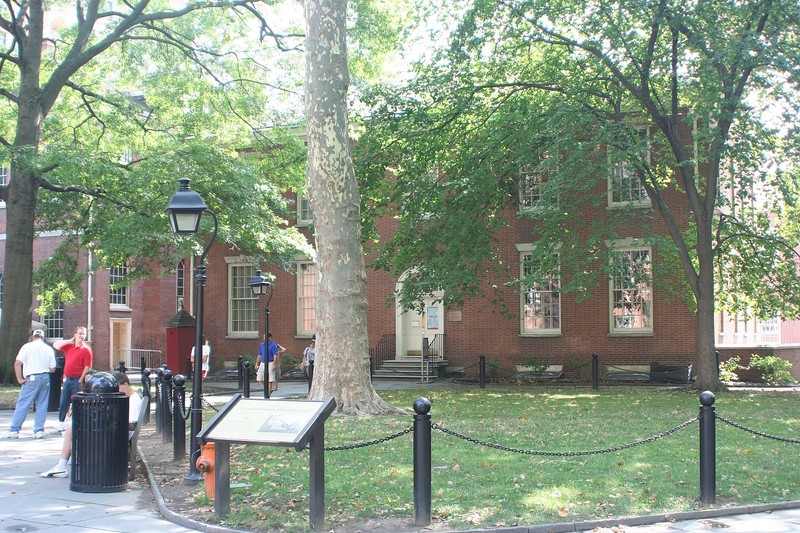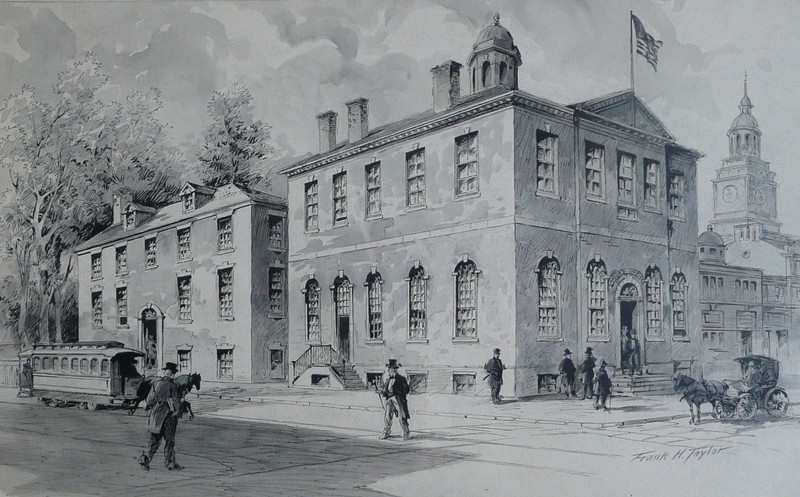American Philosophical Society Museum
Introduction
Text-to-speech Audio
The American Philosophical Society Hall has housed, since its completion in 1789, the organization Benjamin Franklin founded in 1743: The American Philosophical Society. Franklin founded it to stimulate interest in learning and promote "useful knowledge." In addition to Franklin's contributions, Thomas Jefferson served concurrently as U.S. President and president of the American Philosophical Society. The Hall building serves as our nation's first museum, national library, and academy of science. Inside, changing exhibitions highlight the intersections of science, history, and art. Jefferson's handwritten copy of the Declaration of Independence and the Lewis and Clark journals are among the critical documents, scientific specimens, patent models, portraits, maps, rare books, and manuscripts that comprise this extraordinary collection..
Images
Museum at Philosophical Hall in Philadelphia

West side of the American Philosophical Society building in Philadelphia, PA

Original watercolor study for "The Old Structure at Fifth and Chestnut Streets and Philosophical Hall", one of Taylor's "Old Philadelphia" prints, showing Philosophical Hall to the left, Old City Hall to the center right, and the tower of Independence Hall to the far right.

Backstory and Context
Text-to-speech Audio
Franklin founded several societies and organizations, two of which proved significant in the evolution and maturation of the American Philosophical Society. In 1743, he urged creating a community to stimulate an interest in learning. A group responded to Franklin's calling by forming the Philosophical Society, which the American Philosophical Society claims direct descent. However, the newly-formed Society enjoyed little success or participation during its first few decades. In 1768, the rival American Society, which they claim had descended from Ben Franklin's Junto Club (founded in 1727), interjected life into the 1743-created Philosophical Society. The American Society members consisted primarily of people opposed to Pennsylvania's proprietary clique. So, to meet the challenge, the Philosophical Society decided in 1768 to choose eighteen new members, mainly from the supporters of the proprietors: the Penn family. Shortly thereafter, the two rival groups merged into the organization that exists today, and Franklin, who ostensibly founded both groups, served as the newly-formed American Philosophical Society's first president.
As president, Franklin instituted a focus on the sciences, and the Society's journal, Transaction, first published in 1771, stands today as the oldest scholarly journal in America. The Society's first undertaking involved making observations of the transit of Venus, an infrequent occurrence that could provide data used in computing the earth's distance from the sun. The compiled information was transmitted to the Astronomer Royal in England and then published in the Society's first opus, Transactions, vol. 1, in 1771. The Society's findings were met with great acclaim; the Society's findings received the "great eclat" in Europe.
By 1789, the Society met in the now-historic American Philosophical Society Hall. Construction began in 1785, but a lack of funding slowed the building process. Finally, with considerable aid from Benjamin Franklin, the Hall was completed. The two-story, Late Georgian brick building, designed by Samuel Vaughan, received a third-story addition in 1890, but that was removed during a recent restoration. Meanwhile, the Society desired to expand into a national organization; by 1834, a little more than one-third of the 301 members lived within ten miles of the now-historic Hall, with roughly another third living throughout the rest of the U.S. and the rest of the approximately one-third n foreign countries.
In addition to hosting the American Philosophical Society meetings, the building has served as a museum of natural and archeological artifacts, an ipso facto patent office for the arrangement and description of inventions such as John Fitch's steamboat and Franklin's and Rittenhouse's electrical apparatus. The Society's library also includes the Lewis and Clark Expedition records, Jefferson's handwritten copy of the Declaration of Independence, the Mason and Dixon records, and the most comprehensive collection of Ben Franklin artifacts. Furthermore, the library enjoys a focus on American culture and science history, as well as North American Native American linguistics and archaeology.
Sources
The American Philosophical Society. 2019. https://www.amphilsoc.org/.
Benjamin Franklin Historical Society. Accessed January 4, 2022. http://www.benjamin-franklin-history.org. Notably, the section on the Junto Club: http://www.benjamin-franklin-history.org/junto-club/.
Greenwood, Richard E. "Nomination form: American Philosophical Society Hall." National Register of Historic Places. nps.gov. 1974. https://npgallery.nps.gov/GetAsset/532ee879-f8b9-4317-8077-2dc98b3c169d.
Palmieri, Brooke Sylvia. "American Philosophical Society." The Encyclopedia of Greater Philadelphia, provided by Rutgers University." 2016. https://philadelphiaencyclopedia.org/essays/american-philosophical-society/.
https://www.amphilsoc.org/
By Ben Franske - Own work, CC BY-SA 4.0, https://commons.wikimedia.org/w/index.php?curid=4532454
By Artist Frank H. Taylor - http://www.brynmawr.edu/iconog/fht/ofht/ofht.html, Public Domain, https://commons.wikimedia.org/w/index.php?curid=26188322
